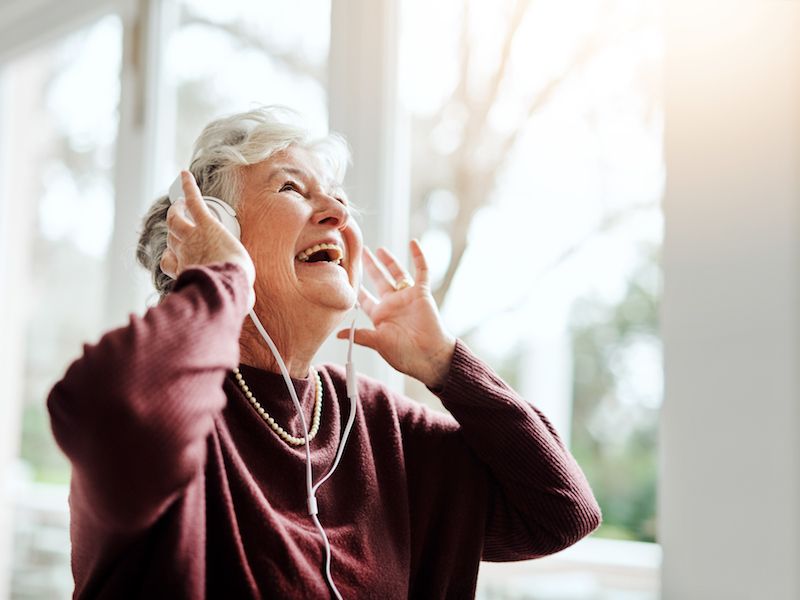
Noise-related loss of hearing doesn’t just affect individuals who work in loud surroundings, such as construction workers or heavy metal roadies. Leisure related noise exposure can be just as dangerous as work related noise exposure. The most common type? Music, gaming, streaming video or anything that you would listen to through headphones or earbuds.
You might not believe your smartphone or tablet can go that loud. The average pain threshold for human hearing is close to 150 db which is well within the range of these devices. This is the volume at which noise begins to literally cause pain in your ears. So what’s the plan to protect against this type of noise-related hearing loss?
It’s important here to consider the volume. A quick shorthand that’s widely recommended is the 60/60 rule: Listen with the volume at or below 60% for 60 minutes or less in a single session (because the length of sound exposure matters, too).
Your Hearing Aids Can be Set up For Music
Make certain, if you’re using hearing aids, you don’t attempt to drown out other sounds by cranking your streaming music up too loud. And there are more appropriate ways to listen to music so consult us about that also. If you’re a musician or someone who loves music you might have noticed that most hearing aids are programmed to improve the quality of voices…not necessarily music. We may be able to change the configuration to decrease feedback and noise while boosting some frequency ranges to better the quality of sound when listening to music.
How to Pick The Best Headphones
When buying headphones there are many choices, specifically if you wear hearing aids. There are some things to consider, though it’s largely a matter of personal preference.
Over-the-Ear Headphones
While the foam-covered speakers that came with your old Walkman are basically no longer used, over-the-ear headphones have had a resurgence. They have lots of options in style and color, are usually endorsed by celebrities, and can be surprisingly expensive. And unlike those little foam pads, these go over the whole ear, stopping outside noises.
Conventional wisdom is that these are less dangerous than in-ear headphones because the source of the sound is further from your eardrum. But because the speakers are bigger they are usually capable of much higher sound level. Noise cancellation can be a good thing as long as you’re not missing out on important sounds like an oncoming car or truck. But on the upside, you won’t need to contend with outside sound so you can enjoy your music at lower volumes.
Earbuds
The standard earbuds that are included with devices like iPhones are known for their inferior quality of sound, but because they come with your phone many people still use them. In addition, with newer versions that don’t have a headphone jack, staying with Apple’s earbuds can simply be easier.
The drawback, aside from the poor sound quality, is that basic earbuds can’t block outside sounds, so you’re more likely to crank up the sound level. It’s generally assumed that placing earbuds so close to your eardrum is the primary concern but it’s actually the volume.
Noise Canceling Earbuds
Many people choose earbuds with a rounded, rubbery tip both because they’re more comfy than normal earbuds and better at stopping outside sounds. A seal that stops outside sound from entering is formed by the rubber tip which molds to the shape of the ear. But these earbuds can also block out sounds you might need to hear and volume is still the primary concern. Obviously, these won’t work for you if you have hearing aids.
Several pairs might need to be tested before you find headphones that meet your specifications. Depending on what you’re most often using them for talking on the phone, say, as opposed to listening to music, you’ll have different acoustic expectations. The important thing is to seek out headphones that make it comfortable for you to listen at a safe and secure volume.
Don’t Cut Corners When it Comes to Your Hearing
Is it Safe, How Can I be certain? If you have a smartphone, you can get an app for that, you can get the National Institute for Occupational Safety and Health’s free Sound Level Meter app. You can get different apps, but studies has discovered that the accuracy of these other apps is hit-and-miss (also, for unknown reasons, Android-based apps have been shown less precise). That prompted NIOSH to create an app of their own. You can measure outside sounds with the app, but sounds coming from your device’s speakers can also be measured, essentially, the actual volume of what’s going to your ears. It’s a little bit of effort, but taking these kinds of protective measures can help safeguard your hearing.






